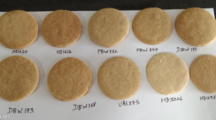Abstract
Superior bread-making quality is required before breeding lines can be commercially classified. In South Africa, breeding lines together with a quality standard from five environments must be submitted for quality analysis for three consecutive seasons before such lines can be classified for commercial use. Breeders depend on falling number and mixograph analysis to indicate which breeding lines must be selected for submission. Time availability determines whether whole flour or white flour will be used for this quick screening process. During the classification process, the lines have to adhere to 11 primary quality criteria, which include hectolitre mass, falling number, grain and flour protein content, flour yield, flour colour, farinograph water absorption, alveograph stability/distensibility ratio, alveograph dough strength, loaf volume and corrected loaf volume. The aim of this study was to compare flour obtained from three different milling procedures, by using six selected Mixsmart parameters as indicators of the primary classification criteria for commercial cultivar release, to determine whether faster milling procedures such as a hammer mill or Junior Quadrumat mill will give the same results as the currently used Bühler mill. Seed of ten genotypes from two environments was used. There were sufficient correlations between the Mixsmart parameters and primary quality criteria, for selection of the best potential breeding lines, whether whole flour, white flour from the Junior Quadrumat mill or flour from the Bühler mill was used. Linear discriminant analysis confirmed that no differences existed between the three milling procedures for mixograph analysis as indicator of quality.


Similar content being viewed by others
References
American Association of Cereal Chemists (AACC) (2000) Approved methods of the American Association of Cereal Chemists, 10th edn. American Association of Cereal Chemists, Incorporated, St Paul, Minnesota
Bass EJ (1988) Wheat flour milling. In: Pomeranz Y (ed) Wheat: chemistry and technology, vol II, 3rd ed. American Association of Cereal Chemists Inc., St. Paul Minnesota, USA, pp 1–68
Bruckner PL, Habernicht D, Carlson GR, Wichman DM, Talbert LE (2001) Comparative bread quality of white flour and whole grain flour for hard red spring and winter wheat. Crop Sci 41:1917–1920
Bruinsma BL, Anderson PD, Rubenthaler GL (1978) Rapid method to determine quality of wheat with the mixograph. Cereal Chem 55:732–735
Levene H (1960) Robust test in the equality of variance. In: Olkin I (ed) Contributions to probability and statistics: essays in honor of Harold Hotelling. Stanford UP, Stanford, pp 278–292
Sedláček T, Horčička P (2014) Prediction of wheat baking quality using reomixer analysis of whole-grain meal. Cereal Research Communications 42:274–281
Shapiro SS, Wilk MB (1965) An analysis of variance test for normality (complete samples). Biometrika 52:591–611
South African Grain Laboratory (SAGL) (2013) Analysis procedure and evaluation norms for the classification of wheat breeders’ lines for the RSA, as revised by Sensako, Pannar, ARC-SG, SA Chamber of baking, National Chamber of Milling, Grain SA and SAGL.
Walker CE, Walker AE, Hazelton JL (1997) Computerising the mixograph: data collection and analysis. In: Walker CE, Hazelton JL, Shogren MD (eds) The mixograph handbook. National Manufacturing Division TMCO, Lincoln, USA, pp 39–43
Author information
Authors and Affiliations
Corresponding author
Ethics declarations
Conflict of interest
The authors declare no conflict of interest.
Additional information
Communicated by F. Békés.
Rights and permissions
About this article
Cite this article
Miles, C., Booyse, M., van Biljon, A. et al. The effect of different milling procedures on dough mixing parameters of hard red bread wheat. CEREAL RESEARCH COMMUNICATIONS 48, 477–483 (2020). https://doi.org/10.1007/s42976-020-00065-6
Received:
Accepted:
Published:
Issue Date:
DOI: https://doi.org/10.1007/s42976-020-00065-6




